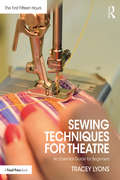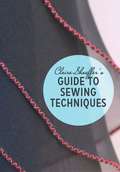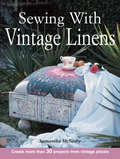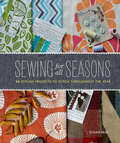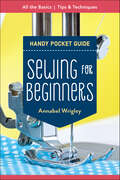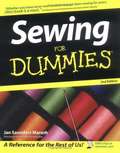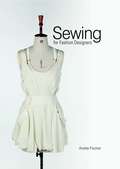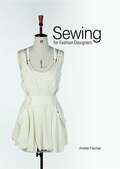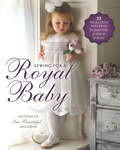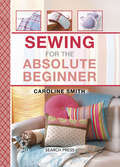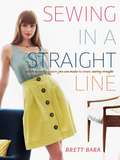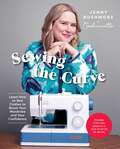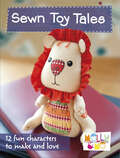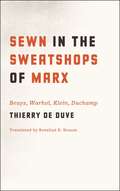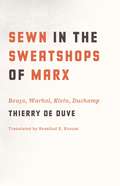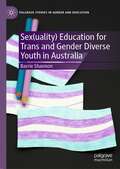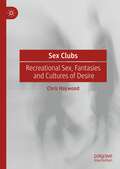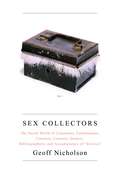- Table View
- List View
Sewing Supplies Handy Pocket Guide: 65+ Tips & Facts for Tools, Notions & Materials
by Carla Hegeman CrimA sewing supplies expert in your pocket This mini book is packed with mega information on common sewing tools, supplies, and materials! Best-selling author Carla Crim of Scientific Seamstress shares 65+ essential nuggets of information on everything from sewing machines and cutting tools to pins, elastic, and thread. Whether you’re wondering how to use a particular interfacing or which sewing machine needle is best for each kind of fabric, you’ll find yourself turning to these useful charts and infographics again and again. Plus, at such a great price, you can afford to buy one for your sewing group, sister, mom, friend, or anyone else you know who loves to sew as much as you do! • Tons of information in one teeny book! Never be stumped by a sewing dilemma again • Tuck it in your purse and take it with you to classes or your favorite shop—the handy size is perfect for your life on the go • Learn about sewing machine feet, pressing tools, marking pens, batting, stuffing, fabric, and more!
Sewing Techniques for Theatre: An Essential Guide for Beginners
by Tracey LyonsSewing Techniques for Theatre: An Essential Guide for Beginners distills the intimidating art of sewing down into simple, quick, and effective lessons to prepare readers for an entry-level position in a costume shop. The lessons follow an hour-by-hour structure, offering detailed instructions to creating 11 sewing samples, a scrub shirt, and a tote bag. Embedded in the projects’ directions are lecture materials on safety, irons, fabric, and patterns. With a wealth of hands-on exercises, review questions, photographs, and step-by-step instructions for compiling a portfolio, this guide teaches aspiring costume technicians about the culture and machinery of the costume shop, and equips them with the necessary skills to begin their career as members of a costume shop team.
Sewing Techniques from Claire Shaeffer's Fabric Sewing Guide
by Claire ShaefferInternationally respected author, lecturer, college instructor and columnist Claire Shaeffer takes an indepth look at a variety of sewing techniques, from piped seams to buttonholes. Step-by-step directions and clear illustrations make this a useful resource for both beginning and advanced sewers.
Sewing With Vintage Linens: Create more than 30 projects from vintage pieces
by Samantha McnesbyCreating home decor with vintage textiles is the latest hot sewing trend, fueled by the resurgence of interest in simpler times and lifestyles. A source of inspiration, ideas and projects, this exciting new book shows you how to locate, purchase, prepare, and assemble vintage textiles to create home decor that reflects these comforting times in a fresh, new way. More than 25 projects range in complexity from simple to advanced, including handkerchief pillows, memory quilts, slipcovers, and an upholstered ottoman. Includes all patterns as well as a fantastic photo gallery of inspirational projects.
Sewing Your Perfect Capsule Wardrobe: 5 Key Pieces with Full-size Patterns That Can Be Tailored to Your Style
by Arianna Cadwallader Cathy McKinnonForeword by Dawn O'PorterA capsule wardrobe is timeless, stylish and effortlessly chic. Composed of go-to pieces that can be dressed up or down, it is the perfect antidote to the overstuffed drawers and ill-fitting cheap outfits from the high street. In this practical but inspiring book, seamstress Arianna Cadwallader and designer Cathy McKinnon present sewing patterns and instructions for the five key pieces that will form the basis of your own capsule wardrobe:A great shift dressWell-fitting trousersA simple yet stylish skirtA light blouse A jersey vestTheir focus is on quality and fit - all the patterns can be adapted to fit and suit you perfectly, whether you prefer long, short or cap sleeves, high or low waistbands, and slim, straight or wide legged trousers. You can then mix and match your garments to create a variety of looks and styles. Aimed at advanced beginners, the book guides you through how to measure yourself and all the techniques you will need. With a foreword by TV star Dawn O'Porter, this is the essential guide to creating your perfect wardrobe.
Sewing Your Perfect Capsule Wardrobe: 5 Key Pieces with Full-size Patterns That Can Be Tailored to Your Style
by Arianna Cadwallader Cathy McKinnonForeword by Dawn O'PorterA capsule wardrobe is timeless, stylish and effortlessly chic. Composed of go-to pieces that can be dressed up or down, it is the perfect antidote to the overstuffed drawers and ill-fitting cheap outfits from the high street. In this practical but inspiring book, seamstress Arianna Cadwallader and designer Cathy McKinnon present sewing patterns and instructions for the five key pieces that will form the basis of your own capsule wardrobe:A great shift dressWell-fitting trousersA simple yet stylish skirtA light blouse A jersey vestTheir focus is on quality and fit - all the patterns can be adapted to fit and suit you perfectly, whether you prefer long, short or cap sleeves, high or low waistbands, and slim, straight or wide legged trousers. You can then mix and match your garments to create a variety of looks and styles. Aimed at advanced beginners, the book guides you through how to measure yourself and all the techniques you will need. With a foreword by TV star Dawn O'Porter, this is the essential guide to creating your perfect wardrobe.
Sewing for All Seasons: 24 Stylish Projects to Stitch Throughout the Year
by Susan BealFrom autumn's bursts of orange and red to spring's lush greens, summer's long-lasting golden light and winter's cool whites and grays, the changing seasons provide endless artistic inspiration. In Sewing for All Seasons, author Susan Beal offers 24 beautiful projects imbued with the spirit of each season. Home sewists will enjoy stitching a cozy patchwork throw for autumn, a bright gardening apron to welcome spring, a colorful picnic quilt for summer, and soft woolen slippers for those chilly winter nights. With how-to illustrations, helpful templates and patterns, tons of color, and eye-catching photography, this book will leap off shelves and inspire crafters all year long.
Sewing for Beginners Handy Pocket Guide: All the Basics; Tips & Techniques
by Annabel WrigleyEverything you need to know for successful sewing This mini pocket guide is packed with mega information curated for sewing beginners! Once you’ve found your perfect pattern, use this guide to lead you through the sewing process to answer all of your questions along the way. Best-selling author Annabel Wrigley shares the fundamental basics on how to get started sewing, as well as information on fabrics, rotary cutters, templates, fusible interfacing, and so much more. Plus, answer every query you have on sewing around corners, sewing by hand, and sewing a button and pom-pom with this guide. Get this for you and a friend to start your sewing journey together! Take it with you anywhere—classes, retreats, anywhere you sew! Quick and easy reference to all things sewing including supplies, fusible interfacing, and a start to finish how to Fall in love with the art of sewing, and share this giftable guide with everyone you know who wants to sew
Sewing for Dummies
by Janice Saunders MareshDo you love to sew-or want to learn how? Then this book will have you in stitches in no time. There's nothing like the feeling of completing a project using beautiful fabrics and great timesaving tools and then sharing it with your family and friends. Plus, learning to sew will save you money too! Before long, you'll be stitching your own hems, repairing split seams, sewing on buttons, and much, much more. Sewing For Dummies is a book for both absolute beginners and experienced sewers. If you're a stone-cold beginner, you'll find everything you need to know to sew beginning-level projects-and the book doesn't assume that you've ever even picked up a needle and thread before. If you've had some experience with sewing, you'll find tips and tricks that it took author Janice Saunders Maresh, a nationally known sewing and serging instructor, years to pick up! You'll discover how to: Master hand and machine stitches Read a sewing pattern Hem a variety of fabrics Negotiate sleeves and pockets Install zippers, buttons, and other fasteners Shape garments with tucks and pleats Adjust projects for better fit and function This updated edition features a fresh 8-page color insert of all the new home decorating projects, including new patterns and instructions for a traditional living room with slipcovered couches and throws; a French country dining room with drapes and slipcovered chairs; and a bedroom with shams, duvets, dustruffles, and window treatments, as well as: a bathroom with a shower curtain and towels hip and funky tote bags the perfect little black dress Complete with lists of quick fix-it tools, sewing fundamentals, and sewing resources, Sewing For Dummies, 2nd Edition, is the fun and easy wayr to get the basics and stitch up a storm in no time!
Sewing for Fashion Designers
by Anette FischerThis comprehensive guide explores the fundamental sewing methods fashion designers need and teaches professional garment construction. Chapter One introduces sewing tools and machinery (including industrial machines). It discusses how to work with patterns and explains cutting-out methods. Chapter Two is devoted to different fabrics and how they work, focusing on the construction of a garment, including fastenings and trimmings, and the use of materials to support structured pieces, such as corsets. Hand-sewing techniques and basic seams are explored in Chapter Three. Techniques are demonstrated with step-by-step photographic guides combined with technical drawings. A guide to making garment details and decorations, such as pockets, waistlines, and necklines, is found in Chapter Four. Chapter Five addresses fabric-specific techniques, for everything from lace to neoprene. The best technical approaches to use for patternmaking and construction are discussed for each fabric. Catwalk images demonstrate how these kinds of techniques are employed by designers.
Sewing for Fashion Designers
by Anette FischerThis comprehensive guide explores the fundamental sewing methods fashion designers need and teaches professional garment construction. Chapter One introduces sewing tools and machinery (including industrial machines). It discusses how to work with patterns and explains cutting-out methods. Chapter Two is devoted to different fabrics and how they work, focusing on the construction of a garment, including fastenings and trimmings, and the use of materials to support structured pieces, such as corsets. Hand-sewing techniques and basic seams are explored in Chapter Three. Techniques are demonstrated with step-by-step photographic guides combined with technical drawings. A guide to making garment details and decorations, such as pockets, waistlines, and necklines, is found in Chapter Four. Chapter Five addresses fabric-specific techniques, for everything from lace to neoprene. The best technical approaches to use for patternmaking and construction are discussed for each fabric. Catwalk images demonstrate how these kinds of techniques are employed by designers.
Sewing for Fashion Designers
by Anette FischerThis comprehensive guide explores the fundamental sewing methods fashion designers need and teaches professional garment construction. Chapter One introduces sewing tools and machinery (including industrial machines). It discusses how to work with patterns and explains cutting-out methods. Chapter Two is devoted to different fabrics and how they work, focusing on the construction of a garment, including fastenings and trimmings, and the use of materials to support structured pieces, such as corsets. Hand-sewing techniques and basic seams are explored in Chapter Three. Techniques are demonstrated with step-by-step photographic guides combined with technical drawings. A guide to making garment details and decorations, such as pockets, waistlines, and necklines, is found in Chapter Four. Chapter Five addresses fabric-specific techniques, for everything from lace to neoprene. The best technical approaches to use for patternmaking and construction are discussed for each fabric. Catwalk images demonstrate how these kinds of techniques are employed by designers.
Sewing for a Royal Baby
by Sew Beautiful Magazine EditorsAny time a royal event takes place-a wedding, a birth-the world takes notice and what captures their attention first is the royal attire. Who would not want their own little prince or princess to be just as beautifully dressed? Sewing for a Royal Baby includes three designs inspired by actual royal garments, including the royal christening gown, as well as a variety of fine heirloom designs exclusively selected by the editors of Sew Beautiful magazine. Sewing for a Royal Baby allows new mothers and grandmothers to create a royal wardrobe for their new little one using the complete patterns and instructions provided with the book and accompanying CD. The patterns are sized differently according to the style, but the gowns start at newborn and go up to 18 months. The bubble goes up to 24 months. Toddler dresses go up to size 4, and the boys' pieces go up to size 3. The companion CD contains all of the project patterns plus two additional slip patterns, the complete Vintage Royal Alphabet machine embroidery template, and most of the embroidery designs (hand and machine) in the book, as well as some appliqué designs, and technique descriptions for: Shadow embroidery Geometric smocking Basic French sewing Lace shaping Hand embroidery Shark's teeth Plackets Neck bindings Piping From bonnets and booties to breathtaking christening gowns and sweet toddler looks, Sewing for a Royal Baby will inspire sewists to create a wardrobe fit for a little prince or princess using a variety of heirloom sewing techniques.
Sewing for the Absolute Beginner (Absolute Beginner Craft)
by Caroline SmithLearn hand and machine sewing techniques and helpful advice to help you create twenty-five fun projects in this amazing guidebook for beginners.This clear and easy-to-follow guide is the ideal tool for the complete beginner to machine sewing. It is packed with sewing expert Caroline Smith’s helpful advice and twenty-five exciting projects, ranging from pillows and curtains, to an apron, children’s playtime tepee and tote bag.It covers all the equipment, tools, terminology and techniques a beginner needs to know, guiding readers from the basic hand stitches right through to more complex techniques. This is a new edition of a best-selling and much-loved title.“This book is an absolute gem! It’s full of really helpful advice and we love the way the techniques are coupled with projects, so that you learn it and then practise it. Some of our particular favourites are the Lined linen basket, Café curtain and Dining chair cover. . . . Highly recommended!” —My Creative Notebook
Sewing in a Straight Line: Quick and Crafty Projects You Can Make by Simply Sewing Straight
by Brett BaraIn just one weekend and using one skill, sewing straight, an entire world of sophisticated, but easily doable projects is open to you. Just about anyone can sew a straight line. And with that simple skill and some basic guidance, crafty expert Brett Bara demonstrates how you can make custom home decor, stylish fashions and one-of-a-kind gifts. "Sewing in a Straight Line" is a step-by-step guide to creating 28 deceptively simple projects that look like they came from a chic boutique, far more impressive than you would expect for such little effort! These easy-to-make items offer quick gratification that even the busiest among us will appreciate. From a flirty two-hour miniskirt to the cutest plush toys, many of the projects take only a spare afternoon. With step-by-step illustrations, clear instructions and loads of helpful hints and customisation ideas, "Sewing in a Straight Line" will quickly make a sewing enthusiast out of anyone.
Sewing the Curve: Learn How to Sew Clothes to Boost Your Wardrobe and Your Confidence
by Jenny RushmoreLearn to sew a wardrobe of confidence-boosting clothes with Sewing the Curve, even if you've never picked up a needle before! When you're curvy or plus size, it can be hard finding clothes that fit well and express your personality – but learning to sew can also be intimidating, especially if you're not in the size range of most beginner sewing patterns. In Sewing the Curve, Jenny Rushmore, the body-positive, plus-size founder of Cashmerette, will have you sewing fantastic clothes – that fit! – in no time, with 6 full-size sewing patterns (UK sizes 16–36/US size 12–32/EUR sizes 44–64) including a wrap skirt, swing dress, quilted jacket and knit pants, to learn with. Start with core skills, from threading a sewing machine, to understanding sewing patterns, and measuring yourself accurately, and then once you've mastered the basic techniques, learn how to put them to the test, and sew your first garment – one you will love to wear, because it's designed for bodies just like yours. By the end of this book, you'll be able to sew clothes with ease and confidence, in any style or fabric, that fit and express your unique style. Sewing the Curve is the perfect companion for Jenny Rushmore's plus size fitting bible, Ahead of the Curve.
Sewing to Sell: How To Sell Locally & Online; The Beginner's Guide to Starting a Craft Business
by Virginia LindsayThe creator of Gingercake Patterns shows you how to share your passion for sewing with the world by starting a successful home business. Maybe you started sewing just for fun. But now you&’ve developed the skills and vision to turn your creative outlet into something more. Making the leap from hobbyist to professional can be intimidating—but Virginia Lindsay is here to help you get off the sidelines and sew your way to a job you truly enjoy. Drawing on her own experience, Lindsay guides you through every aspect of starting your own craft business, from finding your personal sewing style to creating a product line, identifying customers, equipping your studio, pricing and selling your work, marketing yourself, designing your own patterns, and handling the business and legal side of sewing. And that's not all! Virginia also shares 16 projects (all customer-tested) that you can personalize to start sewing and selling right now.
Sewn Spaces
by Joel DewberrySew your own space! Fabric - when it comes to the spaces you inhabit, it's the perfect medium for personal expression. Popular fabric designer Joel Dewberry shows you all the simple ways you can use the fabric to define the spaces in your life. Joel shares more than 25 projects inspired by his Eclectic Modern style to help you bring color, pattern and texture of fabric into the spaces in which you work, play, live: 6 projects for the spaces you work in: Who ever said utility and style can't mix? Make a barista apron that showcases your personality, or a memo board that actually brightens your day! 9 projects for the spaces you play in: When it comes to play, do it your way. Cuddle up with your custom-made teddy bear (complete with a tummy pocket perfect for an mp3 player), or sew a yoga mat carrier that will show your joy of sun salutations. 12 projects for the spaces you live in: Make it distinctly and completely your home. Choose the way to keep warm with a quilted throw you make yourself, or re-upholster that vintage chair find with fabric that brings it back to life! All these projects and more can be found on the pages ofJoel Dewberry's Sewn Spaces. In addition, Joel gives you the tools you'll need to get started. You'll find techniques at the front of the book, templates at the back, and full-size patterns on a convenient tear-out insert. Fabric can enhance, even transform, any of the living spaces you find yourself in each day. So go ahead - sew your own space!
Sewn Toy Tales: 12 Fun Characters to Make and Love (Melly & Me: Fun Fabulous Design)
by Melanie HurlstonMelly & Me present a fun and fabulous collection of personality-packed designs that will have readers sewing adorable toys in no time! Each of the brightly colored characters is a joy to sew for all abilities, making them the perfect gift for children or adults, or a trendy home accessory. Projects combine simple sewing techniques with funky fabrics, embellishments and color palettes to add zing and excitement to readers' sewn toy creations. Easy to follow step by step instructions and quirky photography make this book a delightful gift as well as an irresistible addition to sewing collections.
Sewn in the Sweatshops of Marx: Beuys, Warhol, Klein, Duchamp
by Thierry De DuveJoseph Beuys, Andy Warhol, Yves Klein, and Marcel Duchamp form an unlikely quartet, but they each played a singular role in shaping a new avant-garde for the 1960s and beyond. Each of them staged brash, even shocking, events and produced works that challenged the way the mainstream art world operated and thought about itself. Distinguished philosopher Thierry de Duve binds these artists through another connection: the mapping of the aesthetic field onto political economy. Karl Marx provides the red thread tying together these four beautifully written essays in which de Duve treats each artist as a distinct, characteristic figure in that mapping. He sees in Beuys, who imagined a new economic system where creativity, not money, was the true capital, the incarnation of the last of the proletarians; he carries forward Warhol's desire to be a machine of mass production and draws the consequences for aesthetic theory; he calls Klein, who staked a claim on pictorial space as if it were a commodity, "The dead dealer"; and he reads Duchamp as the witty financier who holds the secret of artistic exchange value. Throughout, de Duve expresses his view that the mapping of the aesthetic field onto political economy is a phenomenon that should be seen as central to modernity in art. Even more, de Duve shows that Marx--though perhaps no longer the "Marxist" Marx of yore--can still help us resist the current disenchantment with modernity's many unmet promises. An intriguing look at these four influential artists, Sewn in the Sweatshops of Marx is an absorbing investigation into the many intertwined relationships between the economic and artistic realms.
Sewn in the Sweatshops of Marx: Beuys, Warhol, Klein, Duchamp
by Thierry de DuveJoseph Beuys, Andy Warhol, Yves Klein, and Marcel Duchamp form an unlikely quartet, but they each played a singular role in shaping a new avant-garde for the 1960s and beyond. Each of them staged brash, even shocking, events and produced works that challenged the way the mainstream art world operated and thought about itself. Distinguished philosopher Thierry de Duve binds these artists through another connection: the mapping of the aesthetic field onto political economy. Karl Marx provides the red thread tying together these four beautifully written essays in which de Duve treats each artist as a distinct, characteristic figure in that mapping. He sees in Beuys, who imagined a new economic system where creativity, not money, was the true capital, the incarnation of the last of the proletarians; he carries forward Warhol’s desire to be a machine of mass production and draws the consequences for aesthetic theory; he calls Klein, who staked a claim on pictorial space as if it were a commodity, “The dead dealer”; and he reads Duchamp as the witty financier who holds the secret of artistic exchange value. Throughout, de Duve expresses his view that the mapping of the aesthetic field onto political economy is a phenomenon that should be seen as central to modernity in art. Even more, de Duve shows that Marx—though perhaps no longer the “Marxist” Marx of yore—can still help us resist the current disenchantment with modernity’s many unmet promises. An intriguing look at these four influential artists, Sewn in the Sweatshops of Marx is an absorbing investigation into the many intertwined relationships between the economic and artistic realms.
Sex (Palgrave Studies in Gender and Education)
by Barrie ShannonThis book examines young trans and gender diverse Australians’ views of school-based sex education. The analysis is informed by a queer epistemology that acknowledges the systematic and institutional erasure of trans subjectivities through highly medicalised systems of categorisation. Drawing on primary qualitative data, the author emphasises the accounts of trans and gender diverse young people as they relate to sex education at school, and how they undertake informal learning about sex, gender and identity in other areas of their lives.Ultimately, the book problematises the assumption that the sex education classroom is the most appropriate vehicle for social justice education in relation to queer issues. Queer issues and sex education tend to be packaged together discursively, deliberately or by association in dominant media narratives. However, this discourse constrains queer identities to the realm of sex and health, and therefore does not engage with the social citizenship of queer people. Further, this limits the capacity of schools and teachers to meaningfully explore diversity in the classroom, as sex education is front-and-centre in the so called ‘culture wars’ about gender, sexuality, youth and schools.
Sex Clubs: Recreational Sex, Fantasies and Cultures of Desire
by Chris HaywoodThis book explores the hidden world of sex clubs. These are not strip clubs, lap dancing clubs, or brothels; these are clubs that men and women visit to have no strings attached sex. Each year sex clubs, traditionally called swingers clubs, are visited by over one million people in the UK. Using social and cultural theory, the author explores the cultures of desire through themes such as erotic hierarchies, atmospheres and power, women and sexual fantasies, men, masculinity and non-consent, hypersexualized black bodies, heterosexuality and queer heteroeroticism and trans desires. From cuckolding to group sex, bareback sex to intergenerational sex, partner swapping and threesomes to BDSM and fetish nights, sex clubs host a diverse range of sexual encounters that are part of a growing trend of recreational sex. Despite there being over 40 clubs in the UK alone, we continue to know very little about who is visiting the club, why they go there and what people do. This book—drawing upon ethnographies, interviews and large-scale quantitative data—is one of the first in the field to systematically collect and critically interrogate sex clubs and their erotic encounters. This will not only be the first sustained social and cultural analysis of sex clubs themselves, but it also aims to lure the reader into the club through discussions of ethnographic encounters, enabling them to experience the unique dynamics of sex clubs and their cultures of desire.
Sex Collectors
by Geoff NicholsonThough you might not encounter the subject in Artforum or stumble across it at Sotheby's, the thriving business of erotica is a mixture of sophistication and seduction, an underground world of eccentric artists and serious collectors. In Sex Collectors, Geoff Nicholson hunts down an assortment of these obsessives around the world. From the Florida grandma with five million dollars' worth of sexual collectibles to Third Eye Blind's manager, who owns more than eighty thousand men's magazines, Nicholson celebrates these collectors and the occasionally beautiful, frequently bizarre, and always fascinating objects they have amassed. He accompanies Linda Lovelace, the star of Deep Throat, as she is taken on a tour of a collection devoted to her. Days spent in the Kinsey archives reveal the cultural artifacts resulting from the sexual awakening of public America, as well as boxes with labels such as "Phallus with Agricultural Tools" and "Scarf Trick when Folded." Nicholson journeys to Germany to visit with the legendary Karl-Ludwig Leonhardt, sex collector extraordinaire of first edition volumes such as Flagellation pour couples pervertis and Tender Bottoms, erotic Picassos, and notes handwritten by the Marquis de Sade. Throughout his exploration of some of the wildest collections in the world, Nicholson's discussion of collecting as an expression of self and psychology goes hand in hand with his gleeful discovery of the seventh giant phallus used in Stanley Kubrick's A Clockwork Orange, Hitler's creepily erotic personalized bookplate, and a woman who has a plaster cast of Jimi Hendrix's penis. Sex Collectors is a winning story of one man's attempt to collect collectors, to reveal the neuroses that drive some people to collect, and to have good, dirty, high-minded fun while doing it.
Sex Collectors
by Geoff NicholsonThough you might not encounter the subject in Artforum or stumble across it at Sotheby's, the thriving business of erotica is a mixture of sophistication and seduction, an underground world of eccentric artists and serious collectors. In Sex Collectors, Geoff Nicholson hunts down an assortment of these obsessives around the world. From the Florida grandma with five million dollars' worth of sexual collectibles to Third Eye Blind's manager, who owns more than eighty thousand men's magazines, Nicholson celebrates these collectors and the occasionally beautiful, frequently bizarre, and always fascinating objects they have amassed. He accompanies Linda Lovelace, the star of Deep Throat, as she is taken on a tour of a collection devoted to her. Days spent in the Kinsey archives reveal the cultural artifacts resulting from the sexual awakening of public America, as well as boxes with labels such as "Phallus with Agricultural Tools" and "Scarf Trick when Folded." Nicholson journeys to Germany to visit with the legendary Karl-Ludwig Leonhardt, sex collector extraordinaire of first edition volumes such as Flagellation pour couples pervertis and Tender Bottoms, erotic Picassos, and notes handwritten by the Marquis de Sade. Throughout his exploration of some of the wildest collections in the world, Nicholson's discussion of collecting as an expression of self and psychology goes hand in hand with his gleeful discovery of the seventh giant phallus used in Stanley Kubrick's A Clockwork Orange, Hitler's creepily erotic personalized bookplate, and a woman who has a plaster cast of Jimi Hendrix's penis. Sex Collectors is a winning story of one man's attempt to collect collectors, to reveal the neuroses that drive some people to collect, and to have good, dirty, high-minded fun while doing it.

